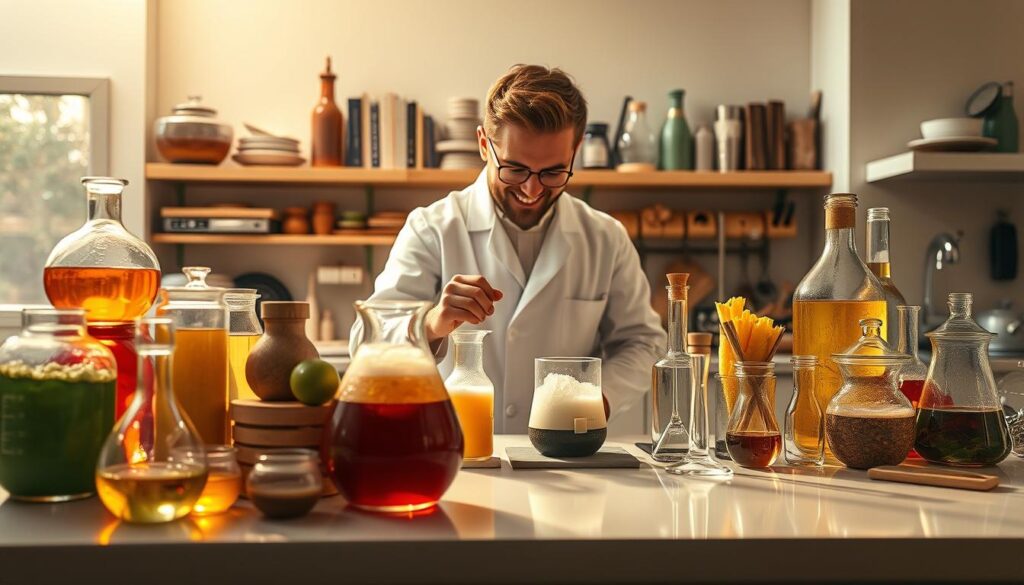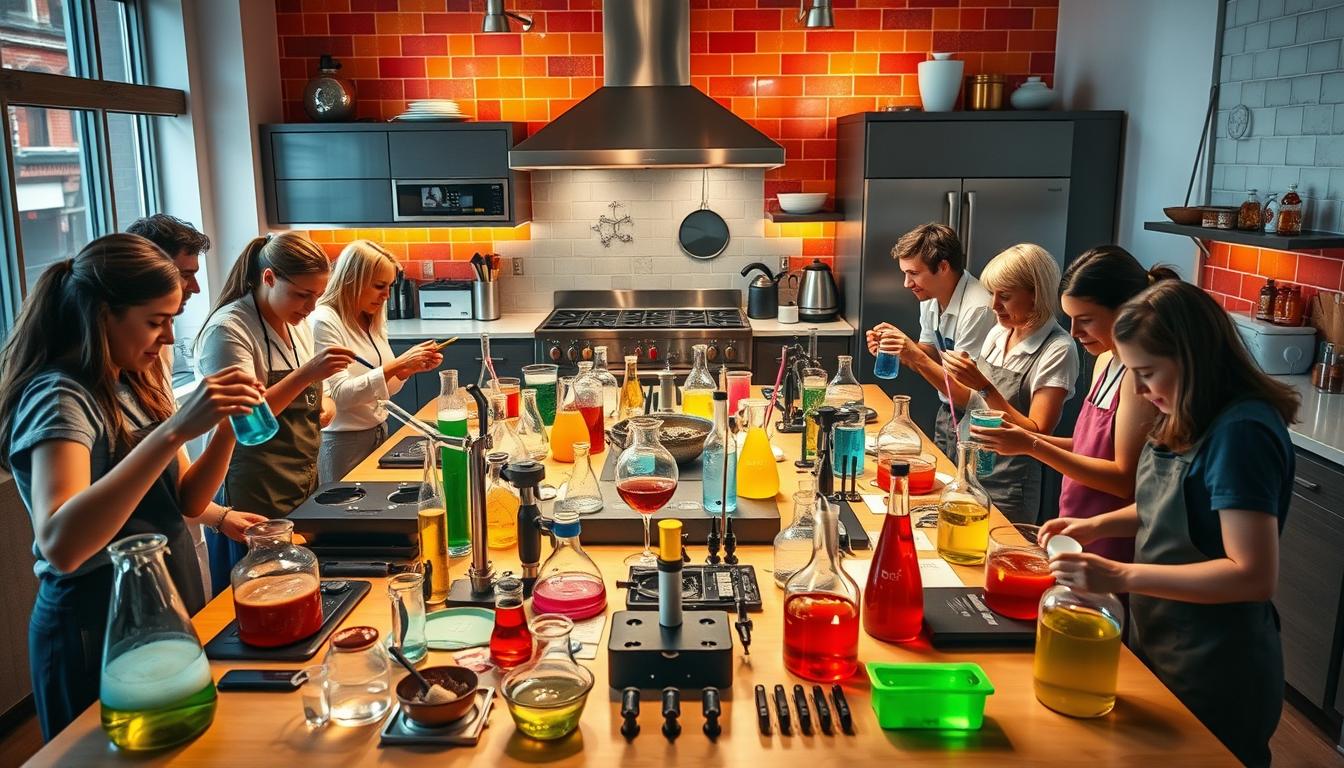We think cooking experiments are a great way to make dinner time fun. Making homemade pasta or pizza is a fun activity that brings everyone together. It’s a way to be creative and work as a team in the kitchen, making meals that everyone will remember.
Interactive recipes, like making your own pizza, are perfect for getting kids involved. Letting them pick their toppings lets them try new things and enjoy cooking. Making homemade pasta is another fun way to learn about different ingredients and cooking methods.
Cooking experiments are a wonderful way to make dinner special and teach kids to love cooking. By making meal prep fun and interactive, we can create tasty and memorable meals. Recipes like homemade pizza are great for getting kids to try new foods and enjoy cooking.
Key Takeaways
- Cooking experiments can be a fun and interactive way to create memorable dinners
- Interactive recipes, such as making homemade pizza, can encourage kids to try new foods and develop a love for cooking
- Cooking experiments, such as making homemade pasta, can be a fun and interactive way to learn about different ingredients and cooking techniques
- Fun and interactive cooking experiments can promote creativity and teamwork in the kitchen
- Cooking experiments can help kids develop a love for cooking and create delicious and memorable meals
- Interactive cooking experiments can be a great way to get kids involved in the cooking process and encourage them to try new foods
Understanding the Importance of Cooking Experiments
Cooking experiments are key in the culinary world. They bring many benefits for both individuals and families. By cooking together, we encourage creativity and teamwork. This makes cooking more fun and a chance for everyone to bond over meals.
Studies show that cooking with kids is very beneficial. Babies start showing curiosity about smells and sounds at six months. Kids in preschool learn 20% more vocabulary by helping in the kitchen. School-aged kids see a 50% boost in math skills when they help cook.
- Improved communication and bonding among family members
- Enhanced creativity and problem-solving skills
- Increased confidence and self-esteem, particularlly among children
- Developed math and reading skills through measuring ingredients and following recipes
- Introduction to new foods and flavors, leading to a more adventurous palate
Benefits of Interactive Cooking
Interactive cooking lets us dive into the cooking process. We get to try new ingredients and techniques. This boosts our sense of pride and makes cooking more enjoyable.
Fostering Creativity in the Kitchen
Cooking experiments spark creativity in the kitchen. They encourage us to think differently and try new things. This leads to innovative recipes and techniques.
By making cooking experiments a part of our lives, we gain many benefits. We see better communication, creativity, and self-esteem. Whether with family or friends, cooking experiments make our culinary adventures more exciting.
Key Ingredients for Our Cooking Experiments
Choosing the right ingredients is key in cooking. We focus on using fresh produce for tasty dishes. Whether it’s a simple salad or a complex sauce, we pick seasonal ingredients for the best taste and texture.
Fresh herbs, citrus fruits, and leafy greens are our go-to ingredients. They add flavor and color to our meals. For homemade pasta, we use fresh eggs, flour, and salt. We also play with spices and seasonings to create new flavors.

Choosing Fresh Produce
Finding the right fresh produce is vital. We choose ingredients that are in season and at their freshest. This ensures great taste and supports local farmers, reducing our carbon footprint. We find fresh produce at farmers’ markets, specialty stores, and our garden.
Essential Kitchen Tools
Having the right kitchen tools is also important. Quality tools can greatly improve our dishes. Our favorites include a good chef’s knife, a cast-iron skillet, and a stand mixer. These tools help us prepare and cook with ease and precision.
Experimenting with Spices
We love trying new spice combinations. Spices can turn a simple dish into something special. Our favorites include basil, oregano, and thyme. We mix them with other ingredients to make delicious sauces and marinades.
Popular Cooking Experiments to Try
We’ve talked about why cooking experiments are key. Now, let’s explore some fun ones to try. These experiments are great for anyone wanting to add excitement to their cooking. You can try making DIY pizza or experimenting with marinades.
Some popular cooking experiments include:
- DIY pizza nights, where you can make your own pizza dough from scratch using flour, yeast, and sauce
- Flavor-packed marinades, where you can experiment with different combinations of herbs and spices to create unique flavors
- Crafting unique desserts, such as homemade ice cream or candy
These cooking experiments are not only fun but also let you be creative. They’re perfect for both beginners and experienced cooks. With popular recipes and DIY pizza nights, you can make tasty meals and have fun.
So, why not try these cooking experiments? You might discover new flavors and dishes. With a bit of creativity, you can make your cooking better and create special meals for your family and friends.
Incorporating Science into Cooking
Exploring cooking experiments shows us how science is key in this art. The chemistry of baking is a cool field that looks at the baking process’s chemical reactions. Knowing these, we can make new, tasty, and pretty recipes.
Our cooking tests also teach us about flavor mixes, a science basic. How ingredients mix and react creates the taste and texture of food. Learning cooking’s science helps us appreciate it more and improve our dishes.
The Chemistry of Baking
The chemistry of baking is essential in cooking tests. It’s about the chemical changes in baking. From mixing ingredients to the Maillard reaction, which makes new flavors, it’s a fascinating area. It helps us make unique, tasty recipes.

Understanding Flavor Combinations
Knowing how to mix flavors is key in cooking tests. By learning the science of flavor mixes, we can make new, exciting dishes. Mixing different ingredients can create a wide range of tastes and textures, making our food better.
Exploring the Maillard Reaction
The Maillard reaction happens when heat meets amino acids and sugars. It creates new flavors in cooked food. Understanding this can help us make dishes that show off the science of cooking.
Engaging Kids with Cooking Experiments
We think it’s key to get kids involved in cooking. It boosts their confidence in the kitchen and helps them eat healthier. Cooking together can also spark their creativity and make them love cooking more.
Studies show that kids who cook are more likely to eat veggies they helped make. A survey by the American Heart Association found that 70% of kids enjoy cooking with family. This shows how important it is to make cooking fun for kids.
- Improved math and reading skills through measuring ingredients and following recipes
- Increased willingness to try new foods and develop healthy eating habits
- Enhanced self-esteem and sense of accomplishment
- Better understanding of food variety and nutrition
By giving kids recipes and fun challenges, we help them learn important skills. They can make everything from cookies to snack boards. Cooking is a great way for kids to learn about food and nutrition in a fun way.
Hosting a Cooking Experiment Dinner Party
Hosting a dinner party with cooking experiments can make it exciting. A themed menu adds a special touch. It can make guests more likely to talk and bond.
To make the space inviting, focus on the ambiance. 85% of guests say the atmosphere is key to their fun. Think about the music, lights, and how the tables are set.
Getting guests involved is also important. 93% of hosts say letting guests help cook makes the event better. You can set up cooking stations or have them help with dishes.
A dinner party with a themed menu can make guests happier by 50%. To plan well, think about how many guests you have and their dietary needs. Aim for 3 appetizers, 4 main dishes, and 2 desserts for variety.
| Course | Options |
|---|---|
| Appetizers | 3 |
| Main Courses | 4 |
| Desserts | 2 |
By using these tips and adding cooking experiments to your dinner party, you can make it unforgettable. A bit of planning and creativity can turn a dinner party with a themed menu into a hit.
Documenting Our Cooking Journey
As we dive into cooking experiments, documenting our journey is key. We capture recipes and tips to reflect on our wins and losses. This way, we can share our experiences and connect with others on social media.
Documenting helps us see where we can improve and learn new skills. For example, we can make a list of tips for capturing recipes. This includes using a camera for quality photos and writing down ingredients and instructions.
- Using a camera to take high-quality photos of our dishes
- Writing down ingredients and instructions in a notebook or digital note-taking app
- Sharing our experiences on social media platforms, such as Instagram or Facebook
Sharing our cooking on social media lets us connect with followers. We get feedback and learn from others. This builds a community and sparks creativity in the kitchen.
Capturing Recipes and Tips
Recording recipes and tips is vital. It creates a knowledge base for future use. We write down recipes, take photos, and note down tips and tricks.
Sharing Our Successes and Failures
Sharing our successes and failures is important. It helps us connect with others facing similar challenges or achievements. This builds a community and encourages sharing and learning.
Engaging on Social Media
Using social media to share our cooking is great. We post photos, recipes, and tips to connect with others. This promotes our journey and offers a platform for sharing and learning.
Safety Tips for Cooking Experiments
Safety is key in cooking experiments. We want our kitchen to be safe and fun for everyone, including kids. The CDC says about 48 million people get sick from food each year. This shows how important food safety is.
To avoid accidents, we must follow some important safety tips. Proper training on kitchen safety can cut accident rates by half. This means teaching kids how to use sharp tools and electrical appliances safely. For instance, using a cutting board when handling sharp tools is a simple way to prevent accidents.
Kitchen Safety Essentials
Some key kitchen safety essentials include:
- Using oven mitts to handle hot pans and dishes
- Keeping a fire extinguisher in the kitchen
- Ensuring proper ventilation to prevent gas buildup
Food Safety Practices
Food safety practices are also key to avoiding foodborne illnesses. This includes:
- Washing hands regularly, before and after handling food
- Storing food at the correct temperature
- Cooking food to the recommended internal temperature
By following these safety tips and food safety practices, we can have a safe and fun cooking experience. Cooking experiments should be enjoyable, not dangerous. Let’s always prioritize kitchen and food safety in our cooking adventures.
Conclusions and Next Steps in Our Culinary Adventures
Our journey through cooking experiments has left us excited and curious. We’ve learned new ways to enjoy our meals and sparked a love for exploring more. This journey has changed how we see food and cooking.
Encouraging Ongoing Experimentation
The kitchen is a place where creativity knows no bounds. We urge you to keep trying new things. Experiment with different ingredients and flavors. It’s okay to try new things; you might just find something amazing.
Exploring Global Cuisines
The world of food is huge and full of variety. We’ve just started to scratch the surface. We’re ready to dive into global cuisines. From Indian spices to Japanese sushi, there’s so much to explore.
Reflecting on Our Cooking Growth
Looking back, we’re proud of how far we’ve come. We’ve learned new skills, expanded our knowledge, and grown more confident in the kitchen. We’re excited for what’s next and can’t wait to share our experiences with others.

